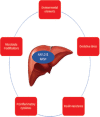Nonalcoholic fatty liver disease: The role of quercetin and its therapeutic implications
- PMID: 34810376
- PMCID: PMC8656328
- DOI: 10.4103/sjg.sjg_249_21
Nonalcoholic fatty liver disease: The role of quercetin and its therapeutic implications
Abstract
Nonalcoholic fatty liver disease (NAFLD) is the most common form of chronic liver disease, affecting almost one-third of the general population and 75% of obese patients with type 2 diabetes. The aim of this article is to review the current evidence concerning the role of quercetin, a natural compound and flavonoid, and its possible therapeutic effects on this modern-day disease. Despite the fact that the exact pathophysiological mechanisms through which quercetin has a hepatoprotective effect on NAFLD are still not fully elucidated, this review clearly demonstrates that this flavonoid has potent antioxidative stress action and inhibitory effects on hepatocyte apoptosis, inflammation, and generation of reactive oxygen species, factors which are linked to the development of the disease. NAFLD is closely associated with increased dietary fat consumption, especially in Western countries. The hepatoprotective effect of quercetin against NAFLD merits serious consideration and further validation by future studies.
Keywords: Flavonoids; liver; nonalcoholic fatty liver disease; nonalcoholic steatohepatitis; quercetin.
Conflict of interest statement
None
Figures
References
-
- Vernon G, Baranova A, Younossi ZM. Systematic review: The epidemiology and natural history of non-alcoholic fatty liver disease and non-alcoholic steatohepatitis in adults. Aliment Pharmacol Ther. 2011;34:274–85. - PubMed
-
- Younossi ZM, Koenig AB, Abdelatif D, Fazel Y, Henry L, Wymer M. Global epidemiology of nonalcoholic fatty liver disease-Meta-analytic assessment of prevalence, incidence, and outcomes. Hepatology. 2016;64:73–84. - PubMed
Publication types
MeSH terms
Substances
LinkOut - more resources
Full Text Sources
Medical


